| | Problems with direct watering | Pasture water system trials | Remote pasture water systems benefits | Pasture water systems | Livestock watering alternatives | Water hauling | Water storage | Gravity-fed systems | Options for winter watering livestock at remote locations | Frost-free nose pump
In the past, livestock were turned out to summer pasture and allowed to walk through and drink from any slough, creek, river, or lake available to them. In the winter, livestock either ate snow, or holes were cut in the ice of these natural water sources for them to drink from. When these natural water sources were not available, dugouts were constructed.
Today, allowing livestock direct access to surface water sources is a concern to livestock producers and to other water users. The practice is also a problem for livestock.
Livestock producers want to provide a safe, reliable supply of good quality water for their livestock, and they want to increase their management to better utilize their pastures for livestock production. Many producers are using remote water systems and applying the latest technology available for extended livestock grazing and winter feeding of livestock away from the farmyard.
Livestock producers, like other water users, want to do their part to protect both natural and constructed water sources from environmental damage and to address herd health problems.
Problems with Direct Watering
Allowing livestock direct access to surface water sources has led to a number of environmental, herd health and pasture utilization problems.
Environmental problems
Environmental problems with direct watering include the following:
- damage to banks of streams and dugouts
- siltation problems in spawning areas for fish
- loss of riparian habitat and vegetation
- loss of water storage in dugouts and streams
- nutrient buildup in both the source and downstream water bodies
- rapid growth of weeds and algae
- deterioration in water quality.
Note: There is enough dissolved phosphorus in the manure from one cow in one day to cause an algae bloom in 250,000 gallons (over 1 million L) of water.
Note: The amount of oxygen needed to decompose the manure from one cow for one day will deplete all dissolved oxygen in 8,000 gallons (over 30,000 L) of water.
Herd health problems
A number of herd health problems are related to direct watering:
- increased exposure to water-transmitted diseases, bacteria, viruses and cyst infections
- blue-green algae (cyanobacteria) toxins
- foot rot
- leg injuries
- stress
- death by drowning from falling through the ice or being stuck in mud
- reduced rates of gain.
Poor pasture utilization and nutrient transfer problems
Other problems with direct watering include two aspects:
- overgrazing near the water source
- poor nutrient transfer caused by an accumulation of manure in the area near the water source
Pasture Water System Trials
Both poor access to water and poor water quality can affect livestock behaviour and production on pasture. In a pasture trial, however, it is extremely difficult to isolate what, how and when these factors become significant because there are so many variables in the cattle, the pasture grass, the water source and the water quality.
Some pasture studies have shown a significant increase in cattle production where water was pumped to them versus direct watering from dugouts. Other studies have shown little or no improvement in cattle production. However, the studies have all shown that cattle prefer to have good quality water be pumped to them instead of direct watering from a dugout.
Note: There are many benefits to pumping water to cattle and keeping them out of water sources.
Remote Pasture Water Systems Benefits
Benefits of a well planned and constructed pasture water system:
- water source protection and, thus, longer water source life
- improved herd health
- increased livestock production, in some situations
- better pasture utilization
- riparian protection and, thus, a more environmentally friendly livestock industry
- an alternative winter water supply and system for livestock away from the farmyard, which reduces manure hauling costs, manure buildup in the calving area and associated animal health problems.
Note: Where livestock are allowed direct access for watering, the loss in dugout water storage and additional maintenance costs range from $300 to $600 per year for an average pasture dugout.
Pasture Water Systems
A variety of livestock watering methods are available to suit any type of pasture and location. The power options to move water to livestock include solar, wind, fuel, stream flow, mainline electricity and gravity flow. Selecting the most appropriate option can be a challenge.
Consider the following factors when selecting a pasture water system:
- type and location of available water sources
- site locations and conditions (remote location, topography, riparian features)
- type of grazing system (intensive or extensive)
- number of livestock
- access to power source (mainline power, solar, wind, animals, etc.)
- pumping system (amount of lift, automated versus manual)
- flexibility and portability
- reliability and maintenance
- temporary or seasonal water storage
- cost/benefit and cost/animal
- personal preference
Note: Establish a list of priorities for a pasture water system and use some of the natural advantages of the site and equipment.
Livestock Watering Alternatives
There are many viable alternatives to direct watering. These alternatives are described in some detail below.
Access ramps
An access ramp is the minimum improvement that can be made to a water source (see Figures 1a. Cross-section view of access ramp and 1b. Plan view of access ramp). Ramps are most appropriate for large herds of livestock in remote locations (i.e. rangeland pastures) where animals are seldom checked or moved. The reinforced ramps provide better footing for livestock drinking from dugouts, sloughs and streams where soft soils, like peat, exist.
These ramps require a relatively low slope of 5 feet horizontal distance to every 1 foot of vertical drop (or 5 metres to 1 metre drop). Lay down a strip of crushed road gravel preferably with sizes from 1 inch (2.5 cm) diameter down to 10 to 15 per cent fines. The gravel layer should be a minimum of 1 foot (0.3 m) thick. Start the gravel layer 10 to 15 feet (3 - 4.5 m) back from the water’s edge and continue down to below the lowest water level of the dugout. Use a small caterpillar or four-wheel drive tractor to spread and compact the gravel.
In soft soil conditions, place a plastic polygrid or geogrid under the gravel to provide added support. The material comes in 3 or 4 metre wide rolls and can be overlapped for wider ramps.
The water source is usually fenced off, so livestock can only drink from the access ramp. Some producers have found that fencing is not necessary because once the cattle have convenient access to water, with good footing, they will water almost exclusively from the ramp.
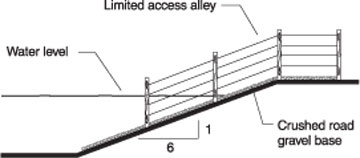
Figure 1a. Cross-section view of access ramp
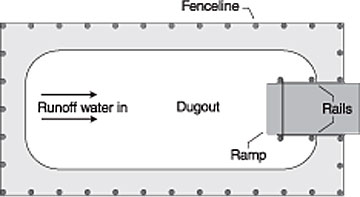
Figure 1b. Plan view of access ramp
Water Hauling
Although it may seem like a step back in time, water hauling can be a viable alternative. In intensive livestock grazing management, cattle are sometimes moved daily from pasture to pasture. Access to water is often the limiting factor. By utilizing an old truck with a main storage tank and an easily moved stock tank, the watering source can be continuously relocated throughout the pasture along with the cattle. The nutrients from the manure are more evenly distributed and are kept on the same field.
Water Storage
Alternative energy powered water pumping systems (including fuel, solar and wind-powered) all require water storage. The water storage tanks or reservoirs provide the necessary livestock water between pumping cycles. Most are raised above the stock tank to allow for the gravity flow of water. They are generally sized to hold a three to seven-day supply of water for cattle.
For sizing the water storage, use the following cattle water consumption rates for cattle on pasture:
- yearling steers or heifers – 8 gallons per day (36 L)
- cow-calf pairs – 12 gallons (55 L) per day
Note: The above are average water consumption rates for cattle on pasture. On hot summer days, peak water consumption can reach 1.5 times these numbers.
Water storages can be made from almost anything as long as they safely store water at a reasonable cost. The most common materials are plastic, fiberglass, concrete or metal tanks, elevated earthen reservoirs, grain bin rings, large rubber tires or large stock watering tanks. The cost of water storages ranges from about 5 cents per gallon (1 cent per L) to over $1.00 per gallon (23 cents per L). The lowest cost water storage (5 to 10 cents per gallon or 1 to 2 cents per L) is the elevated earthen reservoir (see Figure 2).
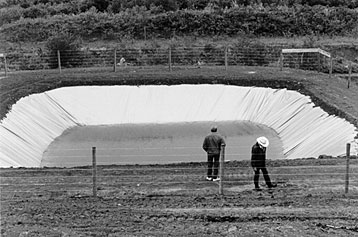
Figure 2. Elevated earthen reservoir with woven polyethylene liner
Gravity-Fed Systems
Gravity-fed systems are ideal systems on sloping pasture land where it is possible to locate a dugout or dam upslope from a watering site. A pipeline can then be run from the dugout downslope into a stock tank. As a rule, the water level in the dugout should be at least 5 feet (1.5 m) higher than the stock tank plus 1 foot (0.3 m) of additional height for every 100 feet (30 m) of pipeline to the stock tank, as shown in Figure 3.
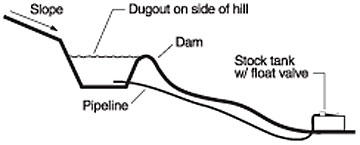
Figure 3. Gravity-fed system
Gravity-fed systems can also be used for springs where there is sufficient elevation drop to the stock tank. On long, undulating and/or steep drops, take extra care to avoid leaks or air blockages.
Note: Consult a knowledgeable contractor or consultant when constructing a gravity-fed system.
Pumped gravity flow reservoirs
These reservoirs are generally constructed by digging a small reservoir on top of the excavated dirt piles from a dugout (similar to Figure 2). A standard backhoe can construct these reservoirs in a few hours. The reservoir is then lined with a woven polyethylene liner to prevent seepage and to keep the water clear. The reservoir bottom must be higher than the top of the stock tank. This approach will provide adequate gravity flow from the reservoir through the water line and float valve assembly and into the stock tank as shown in Figure 4.
Selecting the proper size water line and a high capacity, low-pressure float valve are also important to ensure adequate flow rates. Table 1 shows the dimensions and water volumes for a typical elevated earthen reservoir.
Table 1. Elevated earthen reservoir water volume
Reservoir
dimensions (ft.) | Length x
width x depth | Approximate
water volume |
| Top | Bottom | (Imperial gallons) |
| 25 x 15 x 5 | 15 x 5 x 5 | 5,000 |
| 35 x 15 x 5 | 25 x 5 x 5 | 10,000 |
| 40 x 20 x 5 | 30 x 10 x 5 | 15,000 |
| 45 x 20 x 5 | 35 x 10 x 5 | 20,000 |
| 45 x 25 x 5 | 35 x 15 x 5 | 25,000 |
| 45 x 45 x 5 | 35 x 35 x 5 | 50,000 |
Note: A woven polyethylene liner is placed inside the elevated reservoir to prevent water seepage. Reservoir water volumes are calculated using 1:1 side and end slopes.
Animal-operated pasture pumps
These pasture pumps are commonly called nose pumps because cattle operate them by pushing them with their noses as shown in Figure 5. Nose pump. The pump provides a very low cost (approximately $15 per cow-calf pair) pumping system and is good for about 30 to 40 cow-calf pairs.

Figure 4. Pumped gravity flow reservoirs
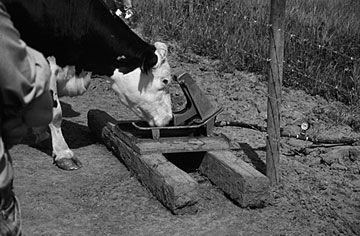
Figure 5. Nose pump
There are five or six manufacturers of nose pumps currently being in the market, including one that makes a frost-free pump suitable for winter use. Some of the pumps are slightly easier to push than others. They all supply approximately 0.2 gallons (1 L) of water for every stroke of the nose device.
The conventional pumps can lift water a maximum of 20 vertical feet (6 m) and, with the use of a shallow buried pipeline, can also be offset a quarter of a mile or more from the water source. The frost-free nose pump uses a piston pump and has been used with over 40 feet (12 m) of lift, but must be located directly above the dugout wet well.
Minimize the amount of elevation lift from the water to make it easier for cows and calves to operate the pump. Shallow burial of the pipeline from the dugout to the pump is recommended to protect the pipeline.
Note: Nose pumps provide a very low cost pumping system; however, cattle must be given time to learn how to operate them.
Although nose pumps are very reliable and easy to move from pasture to pasture, cattle will take a day or so to learn how to operate the pump. This training period is best held at the farmyard after calving and before the cows go out on pasture.
Small calves will generally not learn to operate the pumps until they are about 300 pounds (136 kg). There are several options to overcome this problem. One is to fill a stock tank with water where only calves have access. Another option is to collect some of the water pumped by the cows into a small tub or stock tank for the calves to drink.
Note: Do not try to train livestock to operate the pumps during extremely hot weather.
Pipelines
Shallow buried pipelines are ideal for farms with a very intensive rotational grazing system within one to two miles distance of existing water and mainline power. Pipelines allow livestock producers to better utilize their water source (i.e. usually a well or dugout) rather than constructing many small dugouts scattered around the pastures. They are very flexible systems, and watering sites can be located at the preferred location rather than where a dugout will fill from runoff.
Note: Caution – Telephone your local or provincial agency responsible for underground utilities (e.g. Alberta First Call) to identify the location of shallow buried utility lines before doing any trenching.
For shallow burial (approximately 1 foot or 0.3 m deep) of the pipeline, some producers use a ripper-type plough mounted on either a three-point hitch of a tractor or a pull-type unit. A 1 inch (2.5 cm) diameter plastic pipe can be installed for about 75 cents per foot ($2.50 per m).
It is important to design the system properly to ensure the right combination of pipe size and stock tank. Some producers are also using deeply buried pipelines in several of their pastures close to home. They can then use these pastures year-round for pasture as well as for feeding, bedding, calving and weaning. This approach helps to reduce animal disease problems as well as manure hauling and spreading costs.
In the future, shallow buried pipeline systems will likely become more popular because of their many advantages and due to the shift to more intensive grazing systems.
Note: Further information on pipeline design can be found on the Alberta Agriculture and Rural Development website.
Gas-powered pumping systems
These systems are a low cost alternative for pumping water to larger herds of livestock. They work well in combination with an elevated reservoir system, containing about one week’s water storage. The pumps are very portable and can be moved easily from one water source to the next.
Some producers use a gas-powered generator to run a submersible well or dugout pump. These systems can be automated to start on a float switch device located in a stock tank or reservoir. Both pumps and generators can be used for other purposes on the farm. These systems can be sized to pump a large volume of water from wells and dugouts.
Solar-powered pumping systems
Solar-powered systems are popular because of their reliability and low maintenance. They can be used to pump water from dugouts. An array of solar panels collects and converts sunshine into electrical energy, which can be used to pump water or be stored by rechargeable batteries as illustrated in Figure 6. Due to the variation in sunshine intensity, a minimum of three days water or battery storage is required.
For the solar direct systems without batteries, it is important to match the solar panel’s output (in watts) to the power requirements of the pump for maximum efficiency. For solar systems with batteries, it is important to select good quality deep cycle type batteries (e.g. recreation vehicle type).
It is also important to install electrical controls that have both low and high voltage disconnects. These controls protect the battery from under or over charging conditions; charging problems will drastically reduce battery life. Obviously, a sunny spot is desired for these systems, but also choose a location sheltered from high winds and not in plain view of thieves.
Note: Solar-powered systems are portable and durable.
Solar powered systems have the added advantage of pumping the most water on hot sunny days when cattle are drinking lots of water. Excess power can be used to energize an electric fence for the pasture. Although the initial costs of a solar-powered system are somewhat higher than for others, the system will last for many years. The portability of the solar pumping system is another advantage.
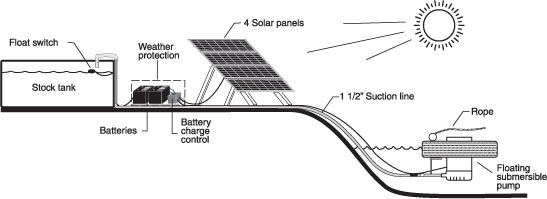
Figure 6. Solar-powered pumping system
Wind-powered pumping systems
Windmills perform best in areas that have higher than average wind speeds, such as the southern parts of the prairie provinces. For central and northern areas of the prairies, where wind speeds are lower, consider adding additional water storage such as an elevated earthen reservoir.
Windmills can be used to pump from dugouts and wells. Place windmills on higher ground where they have good exposure to the wind, such as the excavated dirt pile from a dugout. Also, locate them away from trees as far as possible, at least 15 to 20 times the height of the trees as shown in Figure 7.
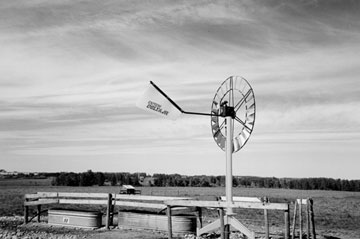
Figure 7. Wind-powered pumping system
There are presently two windmills that can be used for both dugout water pumping and dugout aeration. The initial costs of the system are somewhat high, but most of the windmill systems are very reliable and will last for many years. A windmill system should have at least four days of water storage. Be prepared to use an alternate pumping method or haul water during prolonged calm periods.
Note: Windmills must be located on higher ground away from trees so they perform efficiently.
Groundwater sources
In parts of the Canadian prairies, surface water does not provide a dependable source of water for livestock. The lack of surface water runoff and/or problems with porous soils for storing water are a huge challenge. In these areas, producers drill wells and pump water into stock tanks, large water storages or dugouts for their livestock. For remote locations, gas pumps or animal-operated (nose) pumps can be used for shallow wells of 20 feet lift or less.
A growing number of producers are also using groundwater sources because they are generally much better quality for livestock purposes.
Wind, solar-powered and frost-free nose pump systems can be designed for deeper wells (Figure 8).
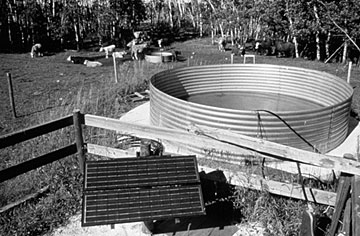
Figure 8. Solar-powered well system
Often, the most viable alternative is a portable generator and submersible pump running water into an earthen reservoir and/or stock tank. Generator systems can also be automated, similar to the remote starting devices for automobiles. In this situation, a float switch is located in the reservoir or stock tank. The float switch starts the generator and pump when the reservoir tank is low and shuts it off when it is full.
Options for Winter Watering Livestock at Remote Locations
Although livestock prefer water, snow is an acceptable water source for mature cows and young cattle in good condition. For snow to be used as a water source, there must be an abundant supply, and it must be clean, unpacked and with no crust so that it is easily accessible by livestock. Provide lactating cows, as well as first and second-calf heifers with water to maintain body condition during the winter months.
In the last five years, many producers have installed winterized pasture water systems from dugouts and water wells to supply water to their livestock. They are using these systems for a number of reasons:
- extending the pasture grazing season and fall and winter swath grazing
- lack of water at the farmyard site
- winter feeding of cattle on pasture and cropland to reduce manure hauling costs
- providing increased flexibility for separating cattle at weaning and calving times
- preventing manure buildup in the calving areas
- reducing animal health problems associated with the above
- death losses due to drowning.
With the proper planning and design, almost all the traditional summer pasture water systems can be modified and used throughout the winter. To prevent freezing, producers need to supply heat, reduce heat loss from the water, drain the unused water to a storage below frost level or a combination of these.
There are many options for winter watering including commercially available “earth-heated” waterers, super insulated “energy-free” waterers and water troughs that rely on the heat stored in the water itself to keep it from freezing, and propane-heated waterers. There are also continuous water flow-through systems to prevent freezing, frost-free animal-operated nose pumps as well as solar and wind-powered pumping systems for winter use.
Each system has its place and when considering choosing an appropriate system, producers must look at a number of factors: personal preference, reliability, livestock herd size, cost, remoteness and the site location. For remote dugout locations on the Prairies, watering systems must be durable and able to withstand temperatures that drop to -40°C.
Most winter watering systems available on the market today have a common set-up. The main components are an intake water line from the dugout, wet well, power source and pump (see Figure 9. Watering bowl with a drain-back system).
The most common pumping systems currently being used during the winter are solar-powered. The solar panels are used to charge batteries that supply electrical power for running a pump. Two basic design concepts prevent freezing: a drain-back system or a well insulated trough system. The basic components of a solar system:
- solar panels
- deep cycle batteries
- battery charge controls
- pump
- a motion detector or float switch to start and stop the pump
- water lines
- a watering bowl or water trough
- other options including a wind turbine to supply additional power for the batteries during extended cloudy periods and an aerator to improve dugout water quality.
Watering bowl with a drain-back system to prevent freezing
This system is set up directly over the wet well beside the dugout and uses a motion sensor to activate the solar-powered pump. The motion sensor starts the pump when livestock approach the watering bowl to drink. Water is pumped into the bottom of a 25 inch (63.5 cm) diameter round watering bowl located on top of a 24 inch (60.96 cm) diameter culvert or wet well.
The water level rises in the bowl to a set of overflow holes that return excess water back into the wet well. These holes are located near the top edge of the bowl to prevent overflow onto the ground. The pump will run as long as there is livestock motion within the range of the motion detector.
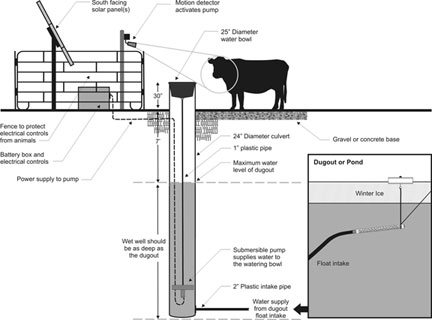
Figure 9. Watering bowl with a drain-back system
To prevent the pump from starting and stopping, a delay is built in to allow the pump to continue running for a pre-set time. This delay allows the next animal to approach the watering bowl and get water before the pump shuts off. Water remaining in the bowl drains back to the wet well through the bottom of the bowl so that no water remains in the bowl to freeze. Motion detection systems are adaptable to a variety of setup configurations as shown in Figure 9.
The ground level at the watering bowl site should be at least 7 feet (2.13 m) higher than the maximum water level of the dugout. This amount of soil cover will prevent frost penetration and freezing of the water in the wet well. Slope the site away to provide good drainage to ensure a dry, clean, safe watering site during mild thaw events.
Well insulated trough system to prevent freezing
Similar to the drain-back system, this trough system is set up directly over the wet well beside the dugout. The solar-powered system pumps water from the wet well into an insulated, doughnut-shaped trough. The float switch signals the pump when the water level is low to keep the trough full. Livestock drink water through access hatches in a fitted, insulated lid that sits on top of the wet well. The trough has several access hatches that can be opened for larger herds.
On extremely cold nights, all but one of the access hatches may have to be covered to prevent heat loss and freezing. This system relies on the heat stored in the incoming water to keep it from freezing and thus must have a minimum number of livestock drinking from it each day during freezing temperatures. This system is shown in Figure 10.
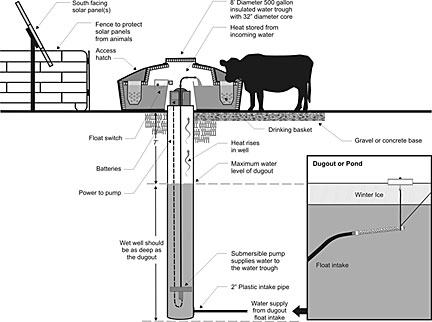
Figure 10. Well insulated trough system
Frost-Free Nose Pump
The frost-free nose pump is also a drain-back type of winter watering system, as shown in Figure 11. Frost-free nose pump. The cows push a nose pad that operates a piston in the bottom of the wet well. The piston lifts the water up into a small drinking bowl. The cow drinks the water out of the bowl, then pumps more water. When the cow is finished drinking, the water in the drop pipe that brings the water up from the well drains below frost.
The pump supplier recommends a maximum of 50 cow/calf pairs per pump. For larger herds, a second pump can be mounted on top of the wet well. Daily inspections of the functioning and icing of the pump are recommended, especially during extremely cold and windy conditions, to ensure adequate water availability for livestock.
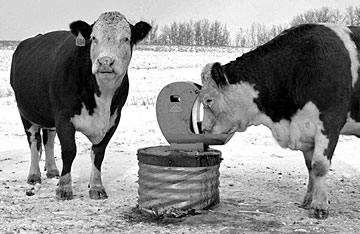
Figure 11. Frost-free nose pump
Summary
No matter the size of a livestock watering system, proper planning and design play an important role in its effectiveness. Good installation cannot compensate for an inadequate water source.
Good quality water and sufficient quantity are both vital to livestock. Dugout and off-stream livestock watering systems are an important tool in protecting water sources, riparian areas and livestock.
Prepared by
Alberta Agriculture and Rural Development
Agriculture Stewardship Division
For more information, contact:
Alberta Ag-Info Centre at 310-FARM (3276)
Source: Agdex 400/716 (C30). December 2007. |
|